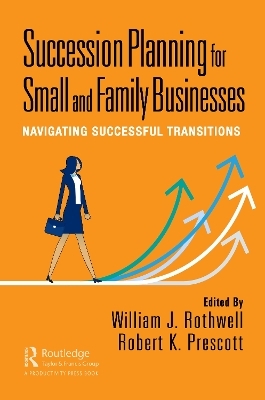
Succession Planning for Small and Family Businesses
Productivity Press (Verlag)
978-1-032-24988-9 (ISBN)
Who will lead your organization into the future? Have you created the systems to properly implement required succession transitions? Have you put the financial tools in place to fund the transition? Do you want a plan that connects with your personal and company core values? When do you include timely planning related to strategy and talent issues? What are the appropriate communication strategies for sharing your plan? What legal issues need consideration related to the strategy, financial, and people aspects of succession?
So, what is preventing you from starting this effort tomorrow? Small and family businesses are the bedrock of all businesses. More people are employed by small and family-owned businesses than by all multinational companies combined. Yet the research on small and family businesses is bleak: fewer than one-third of small business owners in the United States can afford to retire. Only 40% of small businesses have a workable disaster plan in case of the sudden death or disability of the owner, and only 42% of small businesses in the United States have a succession plan. Fewer than 11% of family-owned businesses make it to the third generation beyond the founder. Lack of succession planning is the second most common reason for small business failure.
Many organizations often wonder where to start and what to do. Succession Planning for Small and Family Businesses: Navigating Successful Transitions presents a comprehensive approach to guiding such efforts.
Small and family-owned businesses rarely employ first-rate, well-qualified talent in human resources. More typically, business owners must be jacks-of-all-trades and serve as their own accountants, lawyers, business consultants, marketing experts, and HR wizards. Unfortunately, that does not always work well when business owners embark on planning for retirement or business exits. To help business owners avert problems, this book advises on some of the management, tax and financial, legal, and psychological issues that should be considered when planning retirement or other exits from the business. This comprehensive approach is unique when compared to the books, articles, and other literature that currently exist on the market. This book takes on a bold and integrated approach. Relevant research combined with the rich experiences of the authors connects this thorough, evidence-based approach to action-based approaches for the reader.
William J. Rothwell, Ph.D., SPHR, SHRM-SCP, CPLP Fellow, is President of Rothwell and Associates, Inc., a full-service consulting company that specializes in succession planning. He is also a Professor of Learning and Performance in the Workforce Education and Development program, Department of Learning and Performance Systems, at The Pennsylvania State University, University Park campus. In that capacity, he heads up a top-ranked graduate program in learning and performance. He has authored, co-authored, edited, or co-edited 300 books, book chapters, and articles—including 64 books. Before arriving at Penn State in 1993, he had 20 years of work experience as a Training Director in government and in business. As a consultant, he has worked with over 50 multinational corporations--including Motorola, General Motors, Ford, and many others. In 2004, he earned the Graduate Faculty Teaching Award at Pennsylvania State University, a single award given to the best graduate faculty member on the 23 campuses of the Penn State system. His train-the-trainers programs have won global awards. Robert K. Prescott, Ph.D., SPHR, SHRM-SCP, has spent twenty years in industry and twenty-two years in teaching and consulting positions. Included in Bob’s rich experiences is work in Corporate Engagement at the College of Continuing Studies at The University of Alabama, Graduate Faculty of Management at the Crummer Graduate School of Business at Rollins College in Winter Park, Florida, Director of Executive Education at Penn State and Director of Human Resources for BellSouth Communications, Inc. His consulting initiatives have placed him in advising and teaching positions with such organizations as AAA, ARAMARK, Deloitte, Delphi Automotive Systems, Estee Lauder, Internal Revenue Service (IRS), Lockheed Martin EIS, The National Basketball Association (NBA), Olive Garden Restaurants, Pitney Bowes, Scholastic Book Fairs, The Social Security Administration, T Mobile, UNICEF, Walt Disney World and the U.S. Army. His extensive international work has been with companies such as Corporación Elite, Ecuador, Grupo Industrial de Monclova, Mexico, Mavesa de Venezuela, Minerven, Mota-Engil, Portugal, and the Bermuda Employers Council. In both corporate and academic settings, Bob has taught graduate level courses in the Executive Doctorate, MBA and Masters of Human Resources (MHR) programs and business application training in the areas of strategic leadership, agile leadership, organization behavior, influence strategies, human resource management, supervision, and enterprise consulting. He is a native of Birmingham, Alabama, holds a B.S. in Marketing from the University of Alabama and a Ph.D. in Workforce Education and Development from The Pennsylvania State University. Bob co-authored the books The Strategic Human Resource Leader: How to Prepare Your Organization for the 6 Key Trends Shaping the Future (Davies-Black, 1998), HR Transformation: Demonstrating Leadership in the Face of Future Trends (Davies-Black/SHRM, 2009), and the Encyclopedia of Human Resource Management – Volume One (Wiley, 2012).
Part I Deciding What to Do: Life and Career Planning for Small Business Owners and Family Leaders
Chapter 1: Considering Your Choices
Part II Planning for Succession in Small and Family Business
Chapter 2: Strategic Planning for Succession Sustainability
Chapter 3: Recruiting a Successor from Inside, Outside, or Utilizing Other Options for the Organization
Part III Special Issues in Small and Family Business Succession Planning
Chapter 4: Family-Owned Business Dynamics and Politics
Chapter 5: What Psychological Challenges Affect Small and Family Business Succession?
Chapter 6: Questions and Answers about Legal Issues in Small and Family Business Succession
Chapter 7: Valuing the Small and Family Business for Succession Planning
Chapter 8: Questions and Answers about Financial Planning Issues in Small and Family Business Succession
Chapter 9: Talent Management in Small and Family Businesses
Chapter 10: Transitioning the Business and Executing the Succession Plan
Appendix I Frequently Asked Questions (FAQs)
Appendix II Resources About Small and Family Business Succession Planning
| Erscheinungsdatum | 23.09.2022 |
|---|---|
| Verlagsort | London |
| Sprache | englisch |
| Maße | 178 x 254 mm |
| Gewicht | 167 g |
| Themenwelt | Naturwissenschaften ► Biologie ► Ökologie / Naturschutz |
| Wirtschaft ► Betriebswirtschaft / Management ► Rechnungswesen / Bilanzen | |
| Betriebswirtschaft / Management ► Spezielle Betriebswirtschaftslehre ► Immobilienwirtschaft | |
| Wirtschaft ► Volkswirtschaftslehre | |
| ISBN-10 | 1-032-24988-9 / 1032249889 |
| ISBN-13 | 978-1-032-24988-9 / 9781032249889 |
| Zustand | Neuware |
| Informationen gemäß Produktsicherheitsverordnung (GPSR) | |
| Haben Sie eine Frage zum Produkt? |
aus dem Bereich


